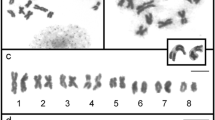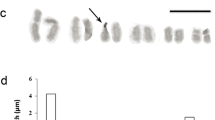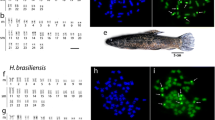Abstract
Chromosomal characteristics, i.e., number, size, morphology, and location of ribosomal DNA (rDNA) clusters were examined in two medically important liver flukes, Fasciola hepatica and Fascioloides magna (Fasciolidae), using conventional Giemsa staining and fluorescent in situ hybridization (FISH) with ribosomal 18S rDNA probe. A comparison of F. magna and F. hepatica karyotypes confirmed significant differences in all chromosomal features. Whilst the karyotype of F. hepatica comprised ten pairs of chromosomes (one metacentric and nine medium-sized subtelocentrics and submetacentrics; 2n = 20, n = 1 m + 5 sm + 4 st; TCL = 49.9 μm), the complement of F. magna was composed of 11 pairs of medium-sized subtelocentrics and submeta-metacentrics (2n = 22, n = 9 st + 1 sm + 1 sm-m; TCL = 35.2 μm). Noticeable differences were found mainly in length and morphology of first chromosome pair. It was metacentric and 9.0 μm long in F. hepatica while subtelocentric and 4.7 μm long in F. magna. Although FISH with rDNA probe revealed a single cluster of ribosomal genes in both species, conspicuous interspecific differences were displayed by chromosomal location of ribosomal loci (i.e., NORs). The signals were found on short arms of fifth homologous pair in F. hepatica; however, they were detected in pericentromeric regions of the long arms of tenth pair in F. magna. The observed cytogenetic differences were interpreted in terms of karyotype evolution of fasciolid flukes; F. hepatica may be regarded phylogenetically younger than F. magna. The present paper provides a pilot study on molecular cytogenetics within a group of hermaphroditic digenetic flukes.





Similar content being viewed by others
References
Ali H, Ai L, Song HQ, Ali S, Lin RQ, Seyni B, Issa G, Zhu XQ (2008) Genetic characterisation of Fasciola samples from different host species and geographical localities revealed the existence of F. hepatica and F. gigantica in Niger. Parasitol Res 102:1021–1024
Bassi R (1875) Sulla cachessia ittero-vermicosa, o marciaia dei Cervi, causata dal Distomum magnum. Med Vet 4:497–515
Bazsalovicsová E, Králová-Hromadová I, Špakulová M, Reblánová M, Oberhauserová K (2010) Determination of ribosomal internal transcribed spacer 2 (ITS2) interspecific markers in Fasciola hepatica, Fascioloides magna, Dicrocoelium dendriticum and Paramphistomum cervi (Trematoda), parasites of wild and domestic ruminants. Helminthologia 47:76–82
Bombarová M, Marec F, Nguyen P, Špakulová M (2007) Divergent location of ribosomal genes in chromosomes of fish thorny-headed worms, Pomphorhynchus laevis and Pomphorhynchus tereticollis (Acanthocephala). Genetica 131:141–149
Bombarová M, Vítková M, Špakulová M, Koubková B (2009) Telomere analysis of platyhelminths and acanthocephalans by FISH and Southern hybridization. Genome 52:897–903
Fletcher HL, Hoey EM, Orr EM, Trudgett A, Fairweather I, Robinson MV (2004) The occurrence and significance of triploidy in the liver fluke, Fasciola hepatica. Parasitology 128:69–72
Foreyt WJ (1996) Susceptibility of bighorn sheep (Ovis canadensis) to experimentally induced Fascioloides magna infections. J Wild Dis 32:556–559
Frydrychová R, Marec F (2002) Repeated losses of TTAGG telomere repeats in evolution of beetles (Coleoptera). Genetica 115:179–187
Fuková I, Nguyen P, Marec F (2005) Codling moth cytogenetics: karyotype, chromosomal location of rDNA, and molecular differentiation of sex chromosomes. Genome 48:1083–1092
Hirai H, LoVerde PT (1996) Identification of the telomeres on Schistosoma mansoni chromosomes by FISH. J Parasitol 82:511–512
Hirai H, Spotila LD, LoVerde PT (1989) Chromosomal localization of DNA repeat elements by in situ hybridization using biotinylated DNA probes. Exp Parasitol 69:175–188
Hirai H, Tanaka M, LoVerde PT (1993) Schistosoma mansoni: Chromosomal localization of female-specific genes and female-specific DNA element. Exp Parasitol 76:175–181
Hirai H, Taguchi T, Saitoh Y, Kawanaka M, Sugiyama H, Habe S, Okamoto M, Hirata M, Shimada M, Tiu WU, Lai K, Upatham ES, Agatsuma T (2000) Chromosomal differentiation of the Schistosoma japonicum complex. Int J Parasitol 30:441–452
Ichikawa M, Itagaki T (2010) Discrimination of the ITS1 types of Fasciola spp. based on a PCR-RFLP method. Parasitol Res 106:757–761
Jaros S, Jaros D, Wesolowska A, Zygner W, Wedrychowics H (2010) Blocking Fasciola hepatica´s energy metabolism—pilot study of vaccine potential of a novel gene—phosphoglycerate kinase. Vet Parasitol 172:229–237
Jones A (2005) Family Fasciolidae Railliet, 1895. In: Jones A, Bray RA, Gibson DI (eds) Keys to the Trematoda, vol 2, CABI Publishing and The Natural History Museum. London, UK, pp 79–86
Králová-Hromadová I, Špakulová M, Horáčková E, Turčeková L, Novobilský A, Beck R, Koudela B, Marinculić A, Rajský D, Pybus M (2008) Sequence analysis of ribosomal and mitochondrial genes of the giant liver fluke Fascioloides magna (Trematoda: Fasciolidae): intraspecific variation and differentiation from Fasciola hepatica. J Parasitol 94:58–67
Králová-Hromadová I, Štefka J, Špakulová M, Orosová M, Bombarová M, Hanzelová V, Bazsalovicsová E, Scholz T (2010) Intra-individual internal transcribed spacer 1 (ITS1) and ITS2 ribosomal sequence variation linked with multiple rDNA loci: a case of triploid Atractolytocestus huronensis, the monozoic cestode of common carp. Int J Parasitol 40:175–181
Levan A, Fredga K, Sandberg A (1964) Nomenclature for centromere position on chromosomes. Hereditas 52:201–220
Li J, He L (1988) Analysis of meiosis and karyotype of Fasciola hepatica. J First Millit Med Univ 1:11. doi: cnki: ISSN: 1000-2588.0.1988-01-020
Li GQ, Jin JS, Wang PY (1988) A study on the chromosomes of Fasciola hepatica. Chin J Veter Sci Technol 6:11–16
Lotfy WM, Brant SV, DeJong RJ, Le TH, Demiaszkiewicz A, Rajapakse RPVJ, Perera VBVP, Laursen JR, Loker ES (2008) Evolutionary origins, diversification and biogeography of liver flukes (Digenea, Fasciolidae). Am J Trop Med Hyg 79:248–255
Mas-Coma S, Bargues MD, Valero MA (2005) Fascioliasis and other plant-borne trematode zoonoses. Int J Parasitol 35:1255–1278
Mas-Coma S, Valero MA, Bargues MD (2009) Fasciola, lymnaeids and human fascioliasis, with a global overview on disease transmission, epidemiology, evolutionary genetics, molecular epidemiology and control. Adv Parasitol 69:41–146
McConville M, Hanna REB, Brennan GP, McCoy M, Edgar HWJ, McConnell S, Castillo R, Hernández-Campos A, Fairweather I (2010) Fasciola hepatica: disruption of spermatogenesis by the fasciolicide compound alpha. Parasitol Res 106:311–323
Nguyen P, Sahara K, Yoshido A, Marec F (2010) Evolutionary dynamics of rDNA clusters on chromosomes of moths and butterflies (Lepidoptera). Genetica 138:343–354
Orosová M, Králová-Hromadová I, Bazsalovicsová E, Špakulová M (2010a) Karyotype, chromosomal characteristics of multiple rDNA clusters and intragenomic variability of ribosomal ITS2 in Caryophyllaeides fennica (Cestoda). Parasitol Int 59:351–357
Orosová M, Marec F, Oros M, Xi BV, Scholz T (2010b) A chromosome study and localization of 18S rDNA in Khawia saurogobii (Cestoda: Caryophyllidea). Parasitol Res 106:587–593
Peng M, Ichinomiya M, Ohtori M, Ichikawa M, Shibahara T, Itagaki T (2009) Molecular characterization of Fasciola hepatica, Fasciola gigantica, and aspermic Fasciola sp. in China based on nuclear and mitochondrial DNA. Parasitol Res 105:809–815
Pybus MJ (2001) Liver flukes. In: Samuel WM, Pybus MJ, Kocan AA (eds) Parasitic diseases of wild mammals. Iowa State Press, Ames, pp 121–149
Rajský D, Čorba J, Várady M, Špakulová M, Cabadaj R (2002) Control of fascioloidosis (Fascioloides magna Bassi, 1875) in red deer and roe deer. Helminthologia 39:67–70
Reblánová M, Špakulová M, Orosová M, Bazsalovicsová E, Rajský D (2010) A description of karyotype of giant liver fluke Fascioloides magna (Trematoda, Platyhelminthes) and a review of Fasciolidae cytogenetics. Helminthologia 47:69–75
Romanenko LN, Pleshanova NM (1975) Chromosome sets of Fasciola hepatica and Fasciola gigantica. Tr VIGIS (Teoreticheskie problemy veterinarnoy geľmintologii) 22:137–142
Sanderson AR (1953) Maturation and probable gynogenesis in the liver fluke, Fasciola hepatica L. Nature 172(4368):110–112
Semyenova SK, Morozova EV, Chrisanfova GG, Gorokhov VV, Arkhipov IA, Moskvin AS, Movsessyan SO, Ryskov AP (2006) Genetic differentiation in eastern European and western Asian populations of the liver fluke, Fasciola hepatica, as revealed by mitochondrial Nad1 and Cox1 genes. J Parasitol 92:525–530
Špakulová M, Králová I (1991) Chromosomes of Fasciola hepatica (Digenea: Fasciolidae) from western Bohemia (CSFR). Helminthologia 28:197–200
Špakulová M, Rajský D, Sokol J, Vodňanský M (2003) Giant liver fluke (Fascioloides magna), an important liver parasite of ruminants. Parpress, Bratislava
Sripa B, Kaewkes S, Intapan PM, Maleewong W, Brindley PJ (2010) Food-borne trematodiases in Southeast Asia: epidemiology, pathology, clinical manifestation and control. Adv Parasitol 72:305–350
Tanaka M, Hirai H, LoVerde PT, Nagafuchi S, Franco GR, Simpson AJG, Pena SDJ (1995) Yeast artificial chromosome (YAC)-based genome mapping of Schistosoma mansoni. Mol Biochem Parasitol 69:41–51
Teofanova D, Kantzoura V, Walker S, Radoslavov G, Hristov P, Theodoropoulos G, Bankov I, Trudgett A (2011) Genetic diversity of liver flukes (Fasciola hepatica) from Eastern Europe. Infect Genet Evol 11:109–115
Walker SM, Prodöhl PA, Fletcher HL, Hanna REB, Kantzoura V, Hoey EM, Trudgett A (2007) Evidence for multiple mitochondrial lineages of Fasciola hepatica (liver fluke) within infrapopulations from cattle and sheep. Parasitol Res 101:117–125
White MJD (1973) Animal Cytology and Evolution. Cambridge University Press, New York
Yin HZ, Ye BY (1990) Studies on the karyotypes of Fasciola spp. Chin J Parasitol Parasitic Dis 8:124–126
Acknowledgements
We are highly indebted to František Marec (Institute of Entomology, Biology Centre ASCR, České Budějovice, Czech Republic) and Tomáš Scholz (Institute of Parasitology, Biology Centre, České Budějovice, Czech Republic) for kind help and providing facilities during research stays of M. R. and M. O. We wish to thank Katarína Oberhauserová (University of Veterinary Medicine and Pharmacy, Department of Nutrition, Dietetics and Animal Breeding, Košice, Slovakia) for providing us with F. hepatica material. The work was supported by the Slovak Research and Development Agency under contracts LPP-0126-07 and APVV-51-062205, and by the Slovak Grant Agency VEGA (2/0148/09 and 2/0014/10). The publication has been created within realization of the project Centre of Excellence for Parasitology (Code ITMS: 26220120022), based on the support of the Operational Programme “Research and Development” funded from the European Fund of Regional Development (rate 0.3).
Author information
Authors and Affiliations
Corresponding author
Rights and permissions
About this article
Cite this article
Reblánová, M., Špakulová, M., Orosová, M. et al. A comparative study of karyotypes and chromosomal location of rDNA genes in important liver flukes Fasciola hepatica and Fascioloides magna (Trematoda: Fasciolidae). Parasitol Res 109, 1021–1028 (2011). https://doi.org/10.1007/s00436-011-2339-y
Received:
Accepted:
Published:
Issue Date:
DOI: https://doi.org/10.1007/s00436-011-2339-y




